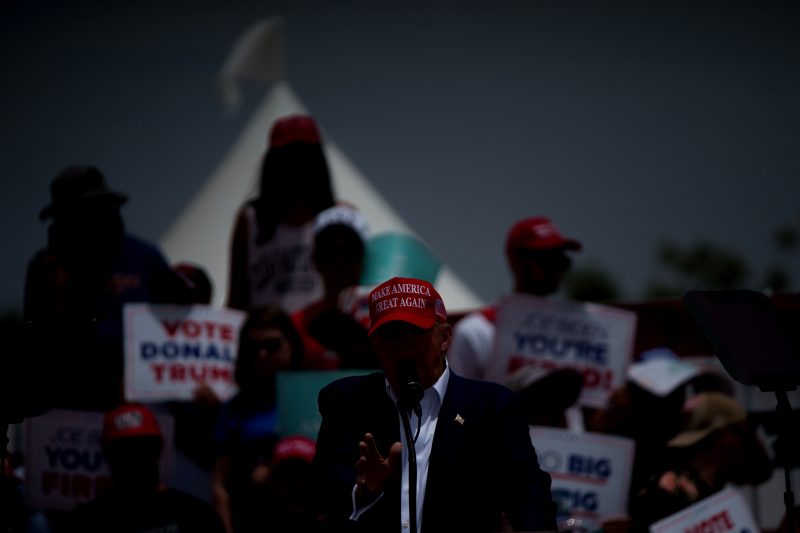Donald Trump has a history of fiery calls urging supporters to rise up, and his most militant fans often have obliged.
So it might seem counterintuitive that now, as Trump faces unprecedented legal problems and a close election in November, the nation is experiencing a lull in political unrest — in fact, one of the quietest periods that extremism researchers have recorded in recent years.
Chief among the factors explaining the lack of political violence, analysts say, is a simple one: Trump’s supporters believe he will win the presidency.
Trump himself has contributed to that certainty by insisting the only way he can lose is if the other side cheats. There’s little reason for pro-Trump extremist groups or radicalized MAGA fans to demonstrate when they foresee the presumptive Republican nominee coasting to victory over President Biden in five months and positioned to enact promised “retribution” against his enemies in seven, political violence trackers say.
Polling shows a tight race: Trump and Biden are roughly tied among registered voters nationally, with Trump tending to hold small leads in several of the all-important battleground states that Biden won four years ago.
But in the eyes of many Trump backers, he is almost certain to prevail if the vote is fair. Their confidence carries risk: Experts warn that should Trump lose, the gap between expectation and reality could make for a highly combustible period after the election.
“They’re assuming that Trump is going to win, and what’s jazzing them up right now is, ‘Then it’s going to be time for retribution,’” said Mary McCord, a former federal prosecutor who now leads the Institute for Constitutional Advocacy and Protection, a Georgetown Law center focused on threats to U.S. security and democracy.
Should Trump lose, however, “it’s just going to be the same thing [as 2020],” she said. “‘This was rigged, they cheated, they stole this.’ That narrative is super dangerous.”
Given a national discourse rife with dehumanizing speech, and studies showing U.S. attitudes becoming more supportive of political violence, many extremism researchers fear the current lull is only a pause. Those fears are compounded, they add, by the hard right’s portrayal of Trump as not just a candidate but a savior, a messiah-like figure who represents their only hope of rescuing the republic from the “radical left.”
Supporters view the former president’s four criminal cases, including one that ended with 34 felony convictions last month, as “deep state” election interference. They printed his mug shot on T-shirts. They compared his indictments to the persecution of Christ. “Jesus went through a sham trial too, and I still follow Him,” reads one popular right-wing meme.
The religious-like fervor around Trump is dangerous, watchdog groups say, because it means a loss in November could turn him into a “martyr” that militant supporters then feel compelled to avenge.
Extremism monitors have warned for years that Trump’s incendiary rhetoric inspires real-world attacks. Assailants have invoked his name in dozens of violent episodes, and his “Stop the Steal” rallies in late 2020 and early 2021 after his election loss became magnets for members of the violent far-right groups that were instrumental in the Capitol attack.
Online chatter about “civil war” has surged when Trump has appeared threatened, from the FBI search of his Florida estate in 2022 to his convictions last month in a Manhattan court.
The Institute for Strategic Dialogue, which monitors extremism, recorded around 9,300 online posts related to civil unrest within a day of Trump’s conviction, nearly the same number after the FBI’s search of Mar-a-Lago. The posts included “hundreds of calls for violence and open fantasies about a violent overthrow of the government.”
“While mass mobilization is unlikely at this time, conspiracy theories encircling this development have the potential to serve as a catalyst for individual acts of violence,” the report concluded.
Serious threats to U.S. federal judges and prosecutors have more than doubled in the past three years, according to a Reuters analysis of data from the U.S. Marshals Service. The data show an increase that began around the time of the 2020 presidential election, when officials were under attack by Trump supporters who rejected his loss.
Prominent election deniers such as Joe Oltmann, a Colorado-based podcaster with a national MAGA following, repeatedly have suggested violence as a way to deal with Democrats and other political foes. In March, Oltmann said on his podcast that President Biden “should be hung by the neck until he’s dead” for supporting a ban on assault weapons.
“The question becomes: When do they stop being armchair warriors and move it back to the physical realm like we saw in the past?” said Rachel Goldwasser, senior research analyst at the Southern Poverty Law Center, which monitors extremist movements.
The “death & destruction” Trump predicted on Truth Social when he was indicted in New York in the spring of 2023 did not come to pass.
Trump was found guilty May 30 in a Manhattan courthouse that had been fortified to withstand a mob attack. In the end, the trial drew Trump political allies eager to demonstrate their loyalty but few rank-and-file supporters.
The meager turnout was in line with new research by extremism monitors that shows a split security picture ahead of the election: high-intensity threats and intimidation online, low-intensity attacks and rallies on the ground.
That equation could change dramatically, however, depending on the outcome of the election. In 2020, the largest spike in far-right demonstrations occurred after the vote that November, said Kieran Doyle, North America research manager for the Armed Conflict Location & Event Data Project, a global conflict monitoring group.
“So far, our data shows that things are less violent, with less far-right organizing than in previous years, but it’s too soon to relax,” Doyle said.
Far-right activity such as armed demonstrations — which surged during the Trump presidency — has plummeted in the past year or so for three key reasons, according to researchers.
One is that pro-Trump extremists don’t see him being in imminent legal peril or in danger of losing the election, so they aren’t staging massive national rallies as they did in late 2020 and early 2021, when “Stop the Steal” protests in Washington drew tens of thousands of Trump supporters from across the country in the false belief that Biden’s win was illegitimate. A February New York Times/Siena poll found that 81 percent of Trump backers believed he would win the 2024 race. (Among Biden supporters, 74 percent said they expect him to win.)
Second is the chilling effect of the Justice Department’s prosecution of rioters who stormed the U.S. Capitol on Jan. 6, 2021. The Proud Boys and the Oath Keepers, two organized extremist movements involved in the attack, haven’t recovered from the blow of losing their national leadership to federal convictions on seditious conspiracy charges.
“Although the Proud Boys are still one of the more active groups in the United States, their current activity is not comparable to what we saw in the lead-up to the previous election,” Doyle said. “And other groups, such as the Three Percenters and Oath Keepers, are more or less inactive.”
Third is that, by keeping online threats at a level researchers call “lawful but awful,” far-right bullies can intimidate their opponents without risking the legal consequences of in-person confrontations.
The success of intimidation campaigns is measured in surveys of elected officials at all levels who say the threats hinder democratic processes by dissuading candidates from seeking election or making leaders fearful of holding public events.
One in six local officials said they’d been threatened in the past three months, according to research by Princeton University’s Bridging Divides Initiative in conjunction with other partners. The figure was one in four for racial and ethnic minorities in local office.
“If threats and harassment are effective in pushing people out of public service or closing down space to participate in all types of democratic practice, then we may not actually see increases in physical violence,” said Shannon Hiller, executive director of the Bridging Divides Initiative.
In the countdown to November, authorities are hardening up security at polling sites and teaching election personnel how to de-escalate hostile situations. Poll workers, election observers, journalists and campaign staffers are taking part in security trainings for the worst-case scenarios.
Extremism researchers are of two minds about the moves. On one hand, they say, the focus on security could scare off voters by exaggerating the risk on Election Day, which historically is calm. On the other, there is a real threat of an unforeseen flash point in the run-up to the vote — and not necessarily related to Trump.
Analysts say the lull could be broken by wild-card events such as a terrorist attack, foreign meddling, or problems at the borders. Even now they are gauging whether the quiet will hold through June, Pride Month, which in recent years has seen a spike in attacks on LGBTQ communities. Doyle, the data researcher, recorded a fourfold increase in far-right activity during Pride last year.
“If this year looks anything like that, this month might be a time when we see an increase in far-right organizing,” he said.
Doyle said white supremacists in particular are emerging as a renewed threat, with public activity increasing rather than receding as with other parts of the militant far right. A federal grand jury this month indicted an Arizona man who is charged in connection with planning a mass shooting of Black people in hopes of triggering a race war before the November election.
McCord, the former federal prosecutor, said the likeliest threat isn’t a Jan. 6-style siege on the Capitol but a targeted attack by an individual acting on conspiracy theories that have traveled from the far right to mainstream conservative circles.
For example, Trump and other prominent Republican figures routinely trade in White racial anxieties and echo tropes from the once-fringe “Great Replacement” theory, which imagines the engineered erasure of White people. Mass shooters have cited those ideas in manifestos that attempt to justify deadly rampages.
“These are lone actors carrying it out,” McCord said, “but they’re not lone actors in the sense of what inspired them.”
Extremism researchers say election denialism is another worrisome factor, with a cottage industry springing up around the conspiracy-fueled idea that the 2020 election was “stolen” from Trump — and that supporters should brace for a similar fight this year.
“They are continuously amped up. They’re constantly active, they’re constantly talking publicly, loudly — videos, forums, anything they can possibly do,” said Goldwasser. “They’re radicalizing people in large numbers.”
Only about a third of Republicans believe Biden’s 2020 election victory was legitimate, according to a December Washington Post-University of Maryland survey that is consistent with other national polling.
Trump has a long record of floating violent ideas should he not get his way, with references to riots and “bedlam.”
Alex Jones, the conspiracy theorist facing a court-ordered liquidation of his assets to pay $1.5 billion he owes for false claims about the Sandy Hook Elementary School shooting, has told followers that there’s no need for violence given the popularity of Trump and the right-wing movement he represents.
As Jones said in a video just after Trump’s conviction: “We are intellectually, culturally, spiritually winning.”
Jones struck a more militant tone, however, when he appeared onstage this month at a far-right political convention in Detroit. He opened with one of his signature lines alluding to how conservatives should respond to what they view as Orwellian overreach by the government: “The answer to 1984 is 1776.”
Jones then led the crowd in chanting: “1776! 1776! 1776!”
Right-wing influencer Jack Posobiec told the audience that Trump’s victory was assured.
“We understand how to beat them, and we are going to take all of them down in just 140 days, on blessed Nov. 5, when Donald J. Trump is reelected president,” he said.
Scott Clement contributed to this report.








